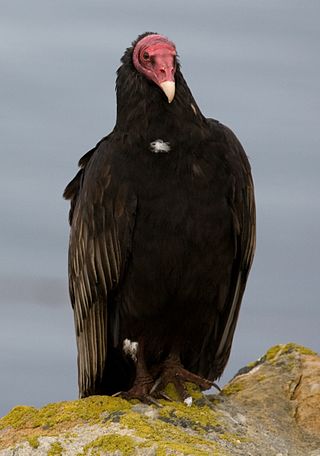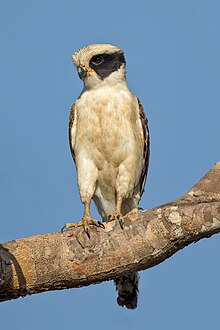
Felidae is the family of mammals in the order Carnivora colloquially referred to as cats. A member of this family is also called a felid. The term "cat" refers both to felids in general and specifically to the domestic cat.

Falcons are birds of prey in the genus Falco, which includes about 40 species. Falcons are widely distributed on all continents of the world except Antarctica, though closely related raptors did occur there in the Eocene.

Birds of prey or predatory birds, also known as raptors, are hypercarnivorous bird species that actively hunt and feed on other vertebrates. In addition to speed and strength, these predators have keen eyesight for detecting prey from a distance or during flight, strong feet with sharp talons for grasping or killing prey, and powerful, curved beaks for tearing off flesh. Although predatory birds primarily hunt live prey, many species also scavenge and eat carrion.

The falcons and caracaras are around 65 species of diurnal birds of prey that make up the family Falconidae. The family likely originated in South America during the Paleocene and is divided into three subfamilies: Herpetotherinae, which includes the laughing falcon and forest falcons; Polyborinae, which includes the spot-winged falconet and the caracaras; and Falconinae, the falcons and kestrels (Falco) and falconets (Microhierax).

A harrier is any of the several species of diurnal hawks sometimes placed in the subfamily Circinae of the bird of prey family Accipitridae. Harriers characteristically hunt by flying low over open ground, feeding on small mammals, reptiles, or birds. The young of the species are sometimes referred to as ring-tail harriers. They are distinctive with long wings, a long narrow tail, the slow and low flight over grasslands and skull peculiarities. The harriers are thought to have diversified with the expansion of grasslands and the emergence of C4 grasses about 6 to 8 million years ago during the Late Miocene and Pliocene.

The Accipitridae is one of the three families within the order Accipitriformes, and is a family of small to large birds of prey with strongly hooked bills and variable morphology based on diet. They feed on a range of prey items from insects to medium-sized mammals, with a number feeding on carrion and a few feeding on fruit. The Accipitridae have a cosmopolitan distribution, being found on all the world's continents and a number of oceanic island groups. Some species are migratory. The family contains 255 species which are divided into 70 genera.

Cathartidae, known commonly as New World vultures or condors, are a family of birds of prey consisting of seven extant species in five genera. It includes five extant vultures and two extant condors found in warm and temperate areas of the Americas. They are known as "New World" vultures to distinguish them from Old World vultures, with which the Cathartidae does not form a single clade despite the two being similar in appearance and behavior as a result of convergent evolution.

The Accipitriformes are an order of birds that includes most of the diurnal birds of prey, including hawks, eagles, vultures, and kites, but not falcons.

Circaetinae is a bird of prey subfamily which consists of a group of medium to large broad-winged species. The group is sometimes treated as tribe Circaetini. These birds mainly specialise in feeding on snakes and other reptiles, which is the reason most are referred to as "snake-eagles" or "serpent-eagles". The exceptions are the bateleur, a more generalised hunter, and the Philippine eagle, which preys on mammals and birds.

An elanine kite is any of several small, lightly-built raptors with long, pointed wings.

The crested goshawk is a bird of prey from tropical Asia. It is related to other diurnal raptors such as eagles, buzzards and harriers, and thus placed in the family Accipitridae.

Caracaras are birds of prey in the family Falconidae. They are traditionally placed in subfamily Polyborinae with the forest falcons, but are sometimes considered to constitute their own subfamily, Caracarinae, or classified as members of the true falcon subfamily, Falconinae. Caracaras are principally birds of South and Central America, just reaching the southern United States.

The laughing falcon is a medium-sized bird of prey in subfamily Herpetotherinae of family Falconidae, the falcons and caracaras. It is found from Mexico south through Central America and in every mainland South American country except Chile and Uruguay.

The plumbeous forest-falcon is a bird of prey in the family Falconidae only found in the Chocó region in Colombia and Ecuador. This rare bird has not been often spotted, which makes its study complicated. For a long time, it was considered to be part of the lined forest-falcons but it now known to be a species of its own. It is currently considered a vulnerable species because of the precarity of its habitat that is threatened by deforestation.

The white-throated caracara or Darwin's caracara is a species of bird of prey in the family Falconidae, the falcons and caracaras. It is found in Argentina and Chile.

The mountain caracara, is a species of bird of prey in the family Falconidae. It is found in puna and páramo in the Andes, ranging from northern Ecuador, through Peru and Bolivia, to northern Argentina and Chile. It is generally uncommon to fairly common. It resembles the closely related Carunculated Caracara and White-throated Caracara, but unlike those species, its chest is uniform black. Juveniles are far less distinctive than the red-faced pied adults, being overall brown with dull pinkish-grey facial skin.

The white-rumped falcon is a species of bird of prey in the family Falconidae native to Indochina. It is placed in its own monotypic genus, Neohierax.

Caracara is a genus in the family Falconidae and the subfamily Polyborinae. It contains one extant species, the crested caracara; and one recently extinct species, the Guadalupe caracara. The South American Classification Committee of the American Ornithological Society has voted to again merge the two, retaining C. plancus as crested caracara. The taxonomists of the International Ornithologists' Union have also merged them.

Falconinae is a subfamily of falconid birds of prey that includes 44 species in three genera. It includes Microhierax, Polihierax, and Falco. Molecular data since 2015 has found support in the grouping of these genera, with Polihierax being paraphyletic in respect to Falco. Falconinae and their sister taxon, Polyborinae, split off from Herpetotherinae around 30.2 million years ago in the Oligocene epoch. Falconines split off from the polyborines around 20 million years ago in the Miocene epoch.

David P. Mindell is an American evolutionary biologist and author. He is currently a senior researcher at the University of California, Berkeley, Museum of Vertebrate Zoology. Mindell's work is focused on the systematics, conservation and molecular evolution of birds, especially birds of prey. He is known for his 2006 book, The Evolving World in which he explained, for the general public, how evolution applies to everyday life.




















